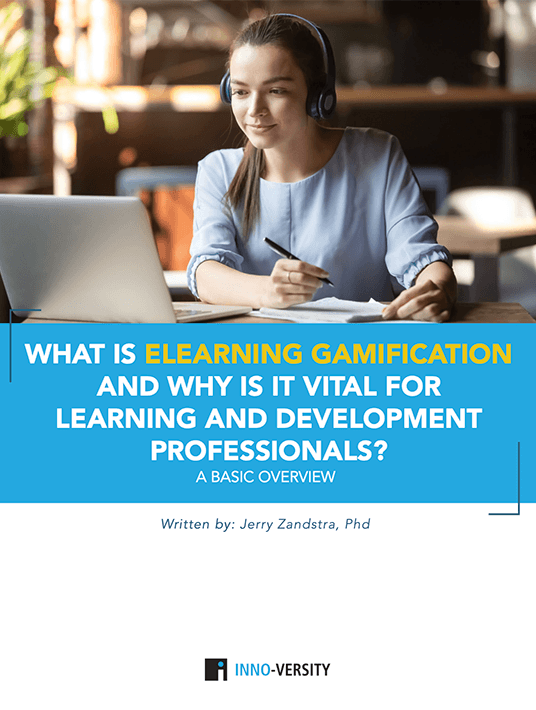Gamification Guru Yu-kai Chou Shares Insights On Gamified Learning
Yu-kai Chou is an entrepreneur, author, lecturer, and business consultant with a remarkable mind for games. His love of games first developed playing video games as a child growing up in South Africa and was one of the very first people to study gamification. Over nearly two decades, he’s written several books and spoken on the topic around the world. In 2015, he was rated number 1 among the “Gamification Gurus Power 100” by RISE, and he received the “Gamification Guru of the Year Award” two years in a row by the World Gamification Congress.

Yu-kai Chou has worked with some of the largest and most prestigious companies in the world. His work has been featured in Forbes and The Wall Street Journal. What you are about to read is a summary of a podcast Jerry Zandstra, Chief Strategy Officer of Inno-Versity, recorded with Yu-kai.
Jerry Zandstra: Thank you for this conversation, Yu-kai. How did you become interested in games and game theory?
Yu-kai Chou: I started my path by being a heavy gamer. I spent thousands of hours playing a game called Diablo II, getting stronger, leveling up, getting stronger in my skills, building allies to complete quests, and so on. At one point, some of my friends started quitting the game and moved on to other games. I quit, too. I was in the transitional period between quitting one game and starting another and I felt empty. All those thousands of hours spent making my character stronger just vanished. Part of my life disappeared.
I started thinking about life as a game that everyone is playing but not everyone is actively playing. I became obsessed with two things. One, how to make life more fun. And two, how to make games more productive. Throughout the years, I started a few technology startups and eventually published The Octalysis Framework, which is a crystallization of all the work that I’ve done. A few years later, because of the book, many people saw me as a leader of the gamification industry.
Jerry Zandstra: Connect for us the world of learning, training, and development with the world of gamification.
Yu-kai Chou: Gamification applies game design, and game design is all about how the brain responds to stimuli. There are a lot of important things that we know we should do: healthcare, education, training. But we don’t necessarily want to do these things. We procrastinate. And then we spend all these hours on games that have no purpose. Once you stop playing, nothing stays with you. People can spend 3, 5, 7, 10 hours a day playing.
My Octalysis Framework breaks down all motivation into 8 core drives. Everything we do is based on one or more of these 8 core drives. Each core drive has a different nature. White Hat makes people feel powerful and good. Black Hat makes people feel urgent, obsessed, even addicted. This includes things like loss and avoidance. For instance, I might be motivated to get trained so that I don’t get fired. I am trying to save my career. Lots of schools operate this way. There are also left brain core drives or extrinsic motivation, which focuses on logic and reason. These are things we do for a reward or purpose or goal. But we don’t necessarily enjoy the activity itself. Once we obtain the goal, we stop doing that activity. The right brain core drives have to do with things we just enjoy doing. Intrinsic motivation. Things we would pay money to experience.
Most companies like to design their learning based on left brain or extrinsic motivation. They do this because it is easy to put a reward or a goal or a certificate in front of someone. This is easier to design for as opposed to designing to make the activity itself fun. The problem is that it creates something we call the "over-justification effect." Science has shown extrinsic motivation kills intrinsic motivation. Let’s say I love to draw and that I draw for free. One of the ways to get me to stop drawing is to first pay me to do it and then pay me less over time. At some point, I will refuse to draw because I won’t draw for free, even though before I got paid, I was willing to draw for free. My intrinsic joy of drawing has been destroyed by the extrinsic motivation of making money.
Jerry Zandstra: So connect this to learning, training, and development.
Yu-kai Chou: We as human beings have an innate desire to learn. We love to learn. We get bored when there is nothing left to learn. Most training programs and education focus on extrinsic motivation: grades, diplomas, certifications, career advancement. We are no longer interested in learning. This is why a lot of people study just to take a test and immediately forget 80% of what they’ve learned. A lot of my work is trying to bring content back from extrinsic to intrinsic motivation. The act of learning and practicing and getting feedback is itself engaging. Finally, it is important to add purpose and understand why people are learning. How the learning will be used beyond just passing a test.
Jerry Zandstra: How do you take these concepts and get them into learning and training design itself?
Yu-kai Chou: The first step is to understand what is already in the system of learning. What is the motivation for people in order to take this training? Most of the time, it is loss and avoidance. Sometimes, it is adding points and badges to tap into accomplishment motivation. But most go toward Black Hat and extrinsic motivation, even with points and badges. The key is to begin to ask how to utilize the right brain core drives or intrinsic motivation. How will you give learners meaningful choices and autonomy?
I suggest you try different strategies, get feedback, and adjust. Build scenario-based learning. Make learning more social and bring people together. Make sure there is new content. Surprise people by giving them what they do not expect. This makes training delightful. Shake up the patterns. Don’t make the solution easy or obvious. Allow people who are learning to see the consequences of their decisions in a scenario and give them the opportunity to go back and make different decisions to improve the outcome.
Jerry Zandstra: Yu-kai, thank you for your time and your willingness to share your thoughts. We greatly appreciate your wisdom and insight.
Download the eBook What Is eLearning Gamification And Why Is It Vital For L&D Professionals? to discover how to bring eLearning gamification into your learning with solid theory and great case studies. Also, join the webinar on the same topic and find out how to create a winning eLearning gamification strategy.

![Gamification Expert Shares Insider Tips On Gamified Learning [Q&A With Yu-kai Chou]](https://cdn.elearningindustry.com/wp-content/uploads/2020/07/Gamification-Expert-Shares-Insider-Tips-On-Gamified-Learning-QA.jpg)







